Critical Analysis of Imposter Phenomenon in Nursing Student Report
VerifiedAdded on 2022/12/20
|8
|1750
|48
Report
AI Summary
This report critically evaluates the article by Christensen et al. (2016) on the imposter phenomenon (IP) experienced by final-year undergraduate nursing students across Australia, New Zealand, and the UK. The report summarizes the study's methodology, which involved surveys using the Clance Imposter Phenomena Scale (CIPS) and the Preparedness for Hospital Placement Questionnaire for Nursing (PHPQN), and its key findings: that most students experience mild to moderate IP. The report highlights the study's strengths, such as its heterogeneous sample and appropriate sample size calculation, and acknowledges its limitations, including the lack of consideration for mental health issues and demographic factors. The author provides a personal response, emphasizing the article's relevance to the transition from nursing student to registered nurse and its implications for nursing curriculum development. The report concludes that the article is credible and valuable for nursing education, despite its limitations, and suggests that curriculum content, rather than clinical placement hours, significantly impacts students' experiences of IP. The report references relevant literature and research to support its analysis.
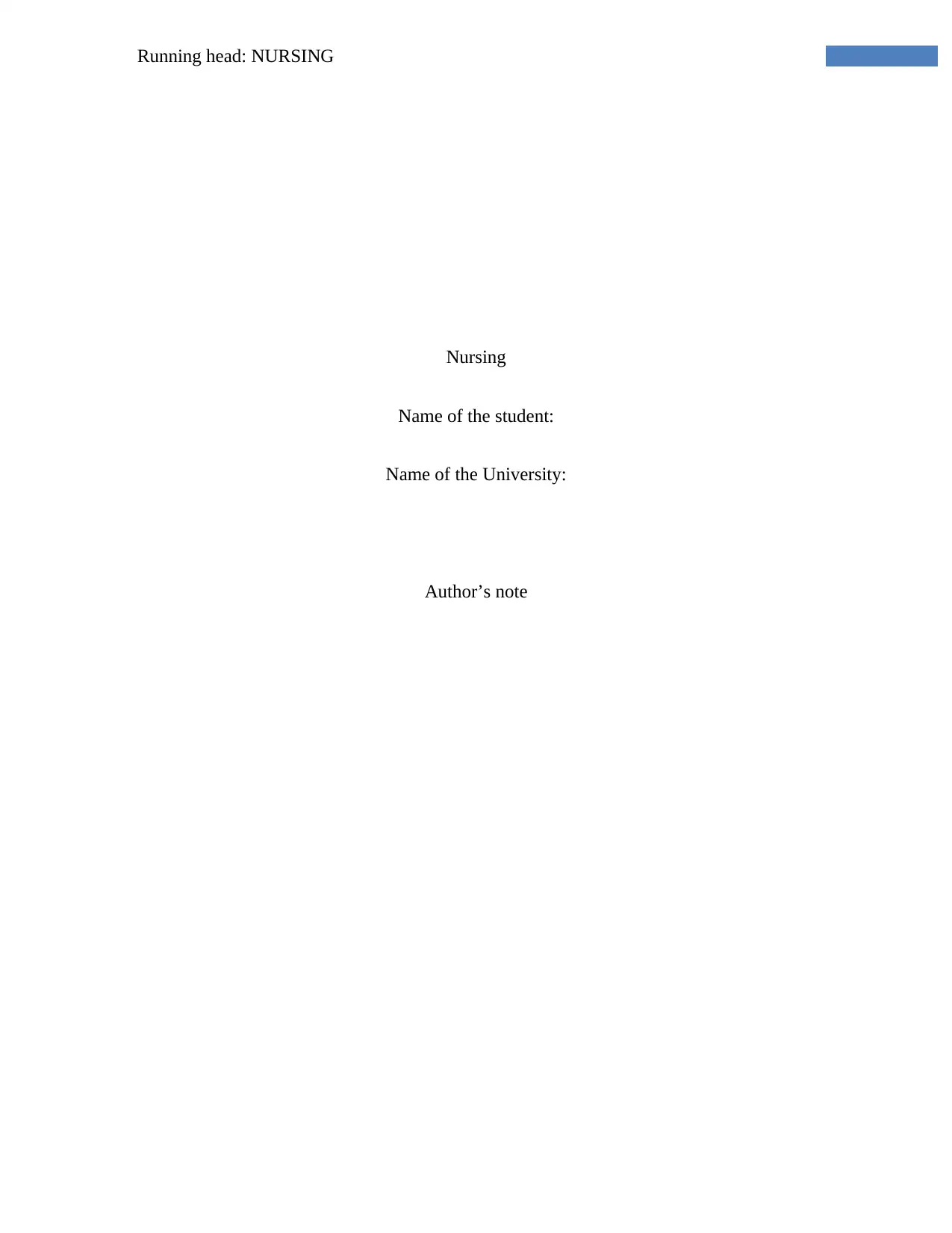
Running head: NURSING
Nursing
Name of the student:
Name of the University:
Author’s note
Nursing
Name of the student:
Name of the University:
Author’s note
Paraphrase This Document
Need a fresh take? Get an instant paraphrase of this document with our AI Paraphraser
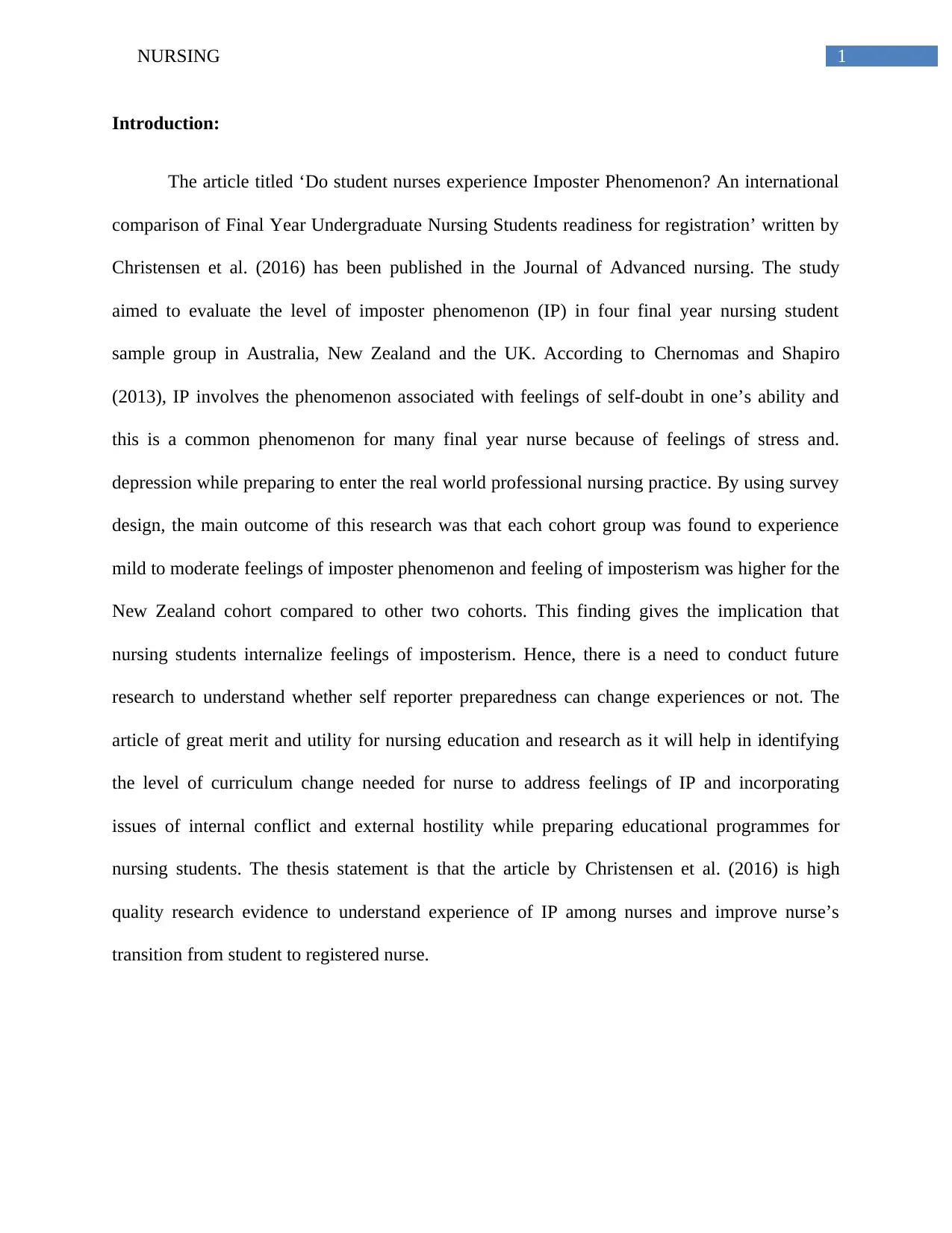
1NURSING
Introduction:
The article titled ‘Do student nurses experience Imposter Phenomenon? An international
comparison of Final Year Undergraduate Nursing Students readiness for registration’ written by
Christensen et al. (2016) has been published in the Journal of Advanced nursing. The study
aimed to evaluate the level of imposter phenomenon (IP) in four final year nursing student
sample group in Australia, New Zealand and the UK. According to Chernomas and Shapiro
(2013), IP involves the phenomenon associated with feelings of self-doubt in one’s ability and
this is a common phenomenon for many final year nurse because of feelings of stress and.
depression while preparing to enter the real world professional nursing practice. By using survey
design, the main outcome of this research was that each cohort group was found to experience
mild to moderate feelings of imposter phenomenon and feeling of imposterism was higher for the
New Zealand cohort compared to other two cohorts. This finding gives the implication that
nursing students internalize feelings of imposterism. Hence, there is a need to conduct future
research to understand whether self reporter preparedness can change experiences or not. The
article of great merit and utility for nursing education and research as it will help in identifying
the level of curriculum change needed for nurse to address feelings of IP and incorporating
issues of internal conflict and external hostility while preparing educational programmes for
nursing students. The thesis statement is that the article by Christensen et al. (2016) is high
quality research evidence to understand experience of IP among nurses and improve nurse’s
transition from student to registered nurse.
Introduction:
The article titled ‘Do student nurses experience Imposter Phenomenon? An international
comparison of Final Year Undergraduate Nursing Students readiness for registration’ written by
Christensen et al. (2016) has been published in the Journal of Advanced nursing. The study
aimed to evaluate the level of imposter phenomenon (IP) in four final year nursing student
sample group in Australia, New Zealand and the UK. According to Chernomas and Shapiro
(2013), IP involves the phenomenon associated with feelings of self-doubt in one’s ability and
this is a common phenomenon for many final year nurse because of feelings of stress and.
depression while preparing to enter the real world professional nursing practice. By using survey
design, the main outcome of this research was that each cohort group was found to experience
mild to moderate feelings of imposter phenomenon and feeling of imposterism was higher for the
New Zealand cohort compared to other two cohorts. This finding gives the implication that
nursing students internalize feelings of imposterism. Hence, there is a need to conduct future
research to understand whether self reporter preparedness can change experiences or not. The
article of great merit and utility for nursing education and research as it will help in identifying
the level of curriculum change needed for nurse to address feelings of IP and incorporating
issues of internal conflict and external hostility while preparing educational programmes for
nursing students. The thesis statement is that the article by Christensen et al. (2016) is high
quality research evidence to understand experience of IP among nurses and improve nurse’s
transition from student to registered nurse.
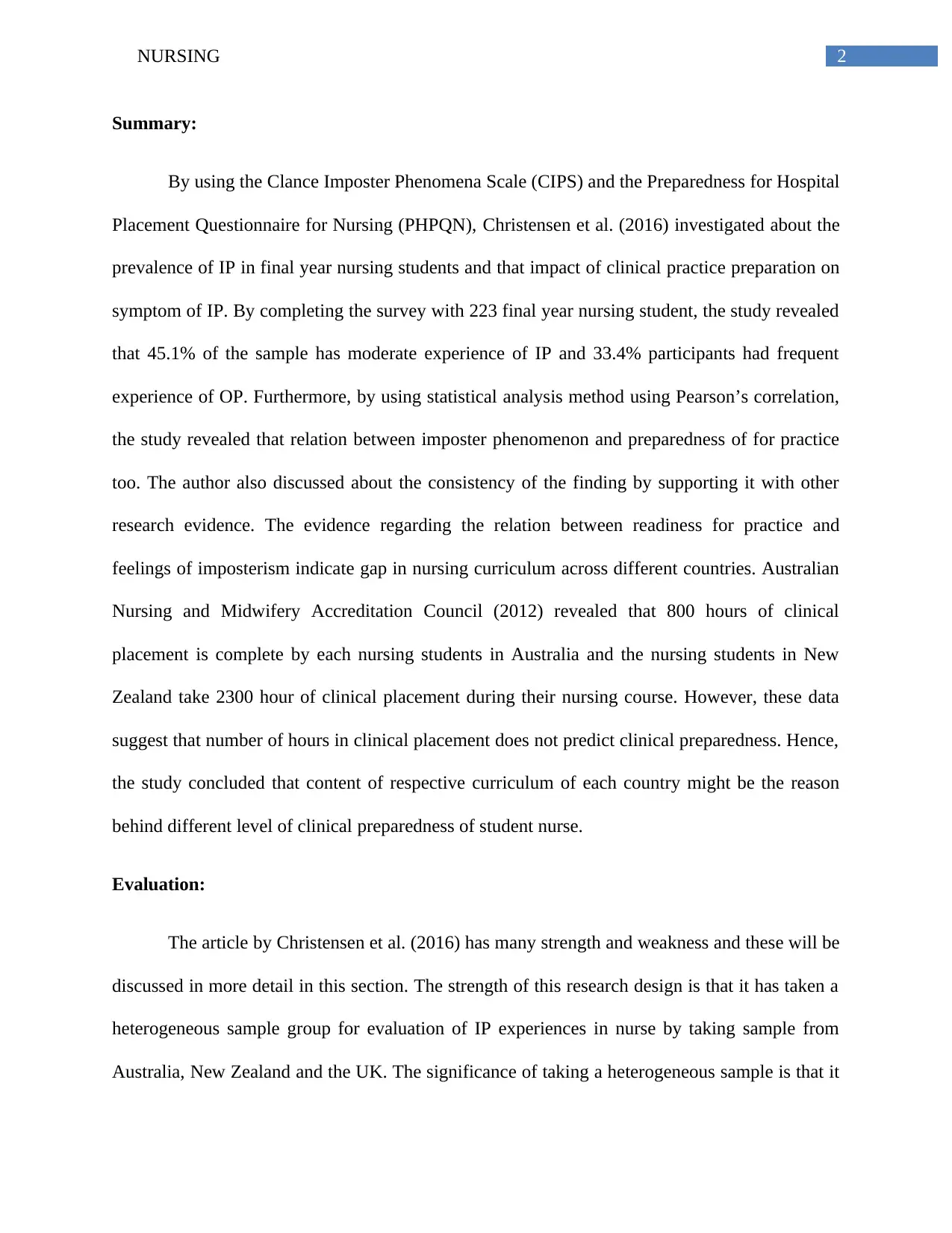
2NURSING
Summary:
By using the Clance Imposter Phenomena Scale (CIPS) and the Preparedness for Hospital
Placement Questionnaire for Nursing (PHPQN), Christensen et al. (2016) investigated about the
prevalence of IP in final year nursing students and that impact of clinical practice preparation on
symptom of IP. By completing the survey with 223 final year nursing student, the study revealed
that 45.1% of the sample has moderate experience of IP and 33.4% participants had frequent
experience of OP. Furthermore, by using statistical analysis method using Pearson’s correlation,
the study revealed that relation between imposter phenomenon and preparedness of for practice
too. The author also discussed about the consistency of the finding by supporting it with other
research evidence. The evidence regarding the relation between readiness for practice and
feelings of imposterism indicate gap in nursing curriculum across different countries. Australian
Nursing and Midwifery Accreditation Council (2012) revealed that 800 hours of clinical
placement is complete by each nursing students in Australia and the nursing students in New
Zealand take 2300 hour of clinical placement during their nursing course. However, these data
suggest that number of hours in clinical placement does not predict clinical preparedness. Hence,
the study concluded that content of respective curriculum of each country might be the reason
behind different level of clinical preparedness of student nurse.
Evaluation:
The article by Christensen et al. (2016) has many strength and weakness and these will be
discussed in more detail in this section. The strength of this research design is that it has taken a
heterogeneous sample group for evaluation of IP experiences in nurse by taking sample from
Australia, New Zealand and the UK. The significance of taking a heterogeneous sample is that it
Summary:
By using the Clance Imposter Phenomena Scale (CIPS) and the Preparedness for Hospital
Placement Questionnaire for Nursing (PHPQN), Christensen et al. (2016) investigated about the
prevalence of IP in final year nursing students and that impact of clinical practice preparation on
symptom of IP. By completing the survey with 223 final year nursing student, the study revealed
that 45.1% of the sample has moderate experience of IP and 33.4% participants had frequent
experience of OP. Furthermore, by using statistical analysis method using Pearson’s correlation,
the study revealed that relation between imposter phenomenon and preparedness of for practice
too. The author also discussed about the consistency of the finding by supporting it with other
research evidence. The evidence regarding the relation between readiness for practice and
feelings of imposterism indicate gap in nursing curriculum across different countries. Australian
Nursing and Midwifery Accreditation Council (2012) revealed that 800 hours of clinical
placement is complete by each nursing students in Australia and the nursing students in New
Zealand take 2300 hour of clinical placement during their nursing course. However, these data
suggest that number of hours in clinical placement does not predict clinical preparedness. Hence,
the study concluded that content of respective curriculum of each country might be the reason
behind different level of clinical preparedness of student nurse.
Evaluation:
The article by Christensen et al. (2016) has many strength and weakness and these will be
discussed in more detail in this section. The strength of this research design is that it has taken a
heterogeneous sample group for evaluation of IP experiences in nurse by taking sample from
Australia, New Zealand and the UK. The significance of taking a heterogeneous sample is that it
⊘ This is a preview!⊘
Do you want full access?
Subscribe today to unlock all pages.

Trusted by 1+ million students worldwide
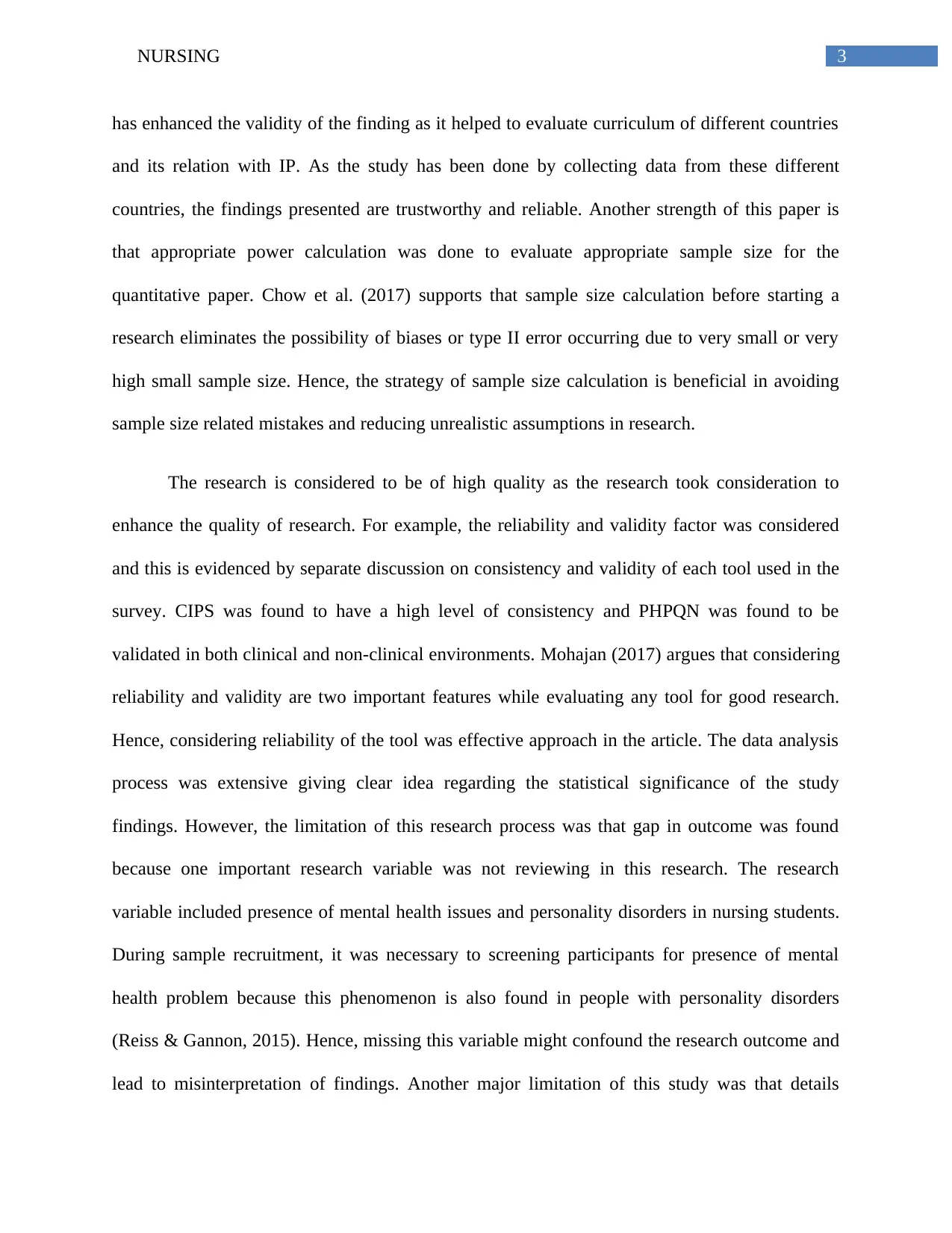
3NURSING
has enhanced the validity of the finding as it helped to evaluate curriculum of different countries
and its relation with IP. As the study has been done by collecting data from these different
countries, the findings presented are trustworthy and reliable. Another strength of this paper is
that appropriate power calculation was done to evaluate appropriate sample size for the
quantitative paper. Chow et al. (2017) supports that sample size calculation before starting a
research eliminates the possibility of biases or type II error occurring due to very small or very
high small sample size. Hence, the strategy of sample size calculation is beneficial in avoiding
sample size related mistakes and reducing unrealistic assumptions in research.
The research is considered to be of high quality as the research took consideration to
enhance the quality of research. For example, the reliability and validity factor was considered
and this is evidenced by separate discussion on consistency and validity of each tool used in the
survey. CIPS was found to have a high level of consistency and PHPQN was found to be
validated in both clinical and non-clinical environments. Mohajan (2017) argues that considering
reliability and validity are two important features while evaluating any tool for good research.
Hence, considering reliability of the tool was effective approach in the article. The data analysis
process was extensive giving clear idea regarding the statistical significance of the study
findings. However, the limitation of this research process was that gap in outcome was found
because one important research variable was not reviewing in this research. The research
variable included presence of mental health issues and personality disorders in nursing students.
During sample recruitment, it was necessary to screening participants for presence of mental
health problem because this phenomenon is also found in people with personality disorders
(Reiss & Gannon, 2015). Hence, missing this variable might confound the research outcome and
lead to misinterpretation of findings. Another major limitation of this study was that details
has enhanced the validity of the finding as it helped to evaluate curriculum of different countries
and its relation with IP. As the study has been done by collecting data from these different
countries, the findings presented are trustworthy and reliable. Another strength of this paper is
that appropriate power calculation was done to evaluate appropriate sample size for the
quantitative paper. Chow et al. (2017) supports that sample size calculation before starting a
research eliminates the possibility of biases or type II error occurring due to very small or very
high small sample size. Hence, the strategy of sample size calculation is beneficial in avoiding
sample size related mistakes and reducing unrealistic assumptions in research.
The research is considered to be of high quality as the research took consideration to
enhance the quality of research. For example, the reliability and validity factor was considered
and this is evidenced by separate discussion on consistency and validity of each tool used in the
survey. CIPS was found to have a high level of consistency and PHPQN was found to be
validated in both clinical and non-clinical environments. Mohajan (2017) argues that considering
reliability and validity are two important features while evaluating any tool for good research.
Hence, considering reliability of the tool was effective approach in the article. The data analysis
process was extensive giving clear idea regarding the statistical significance of the study
findings. However, the limitation of this research process was that gap in outcome was found
because one important research variable was not reviewing in this research. The research
variable included presence of mental health issues and personality disorders in nursing students.
During sample recruitment, it was necessary to screening participants for presence of mental
health problem because this phenomenon is also found in people with personality disorders
(Reiss & Gannon, 2015). Hence, missing this variable might confound the research outcome and
lead to misinterpretation of findings. Another major limitation of this study was that details
Paraphrase This Document
Need a fresh take? Get an instant paraphrase of this document with our AI Paraphraser
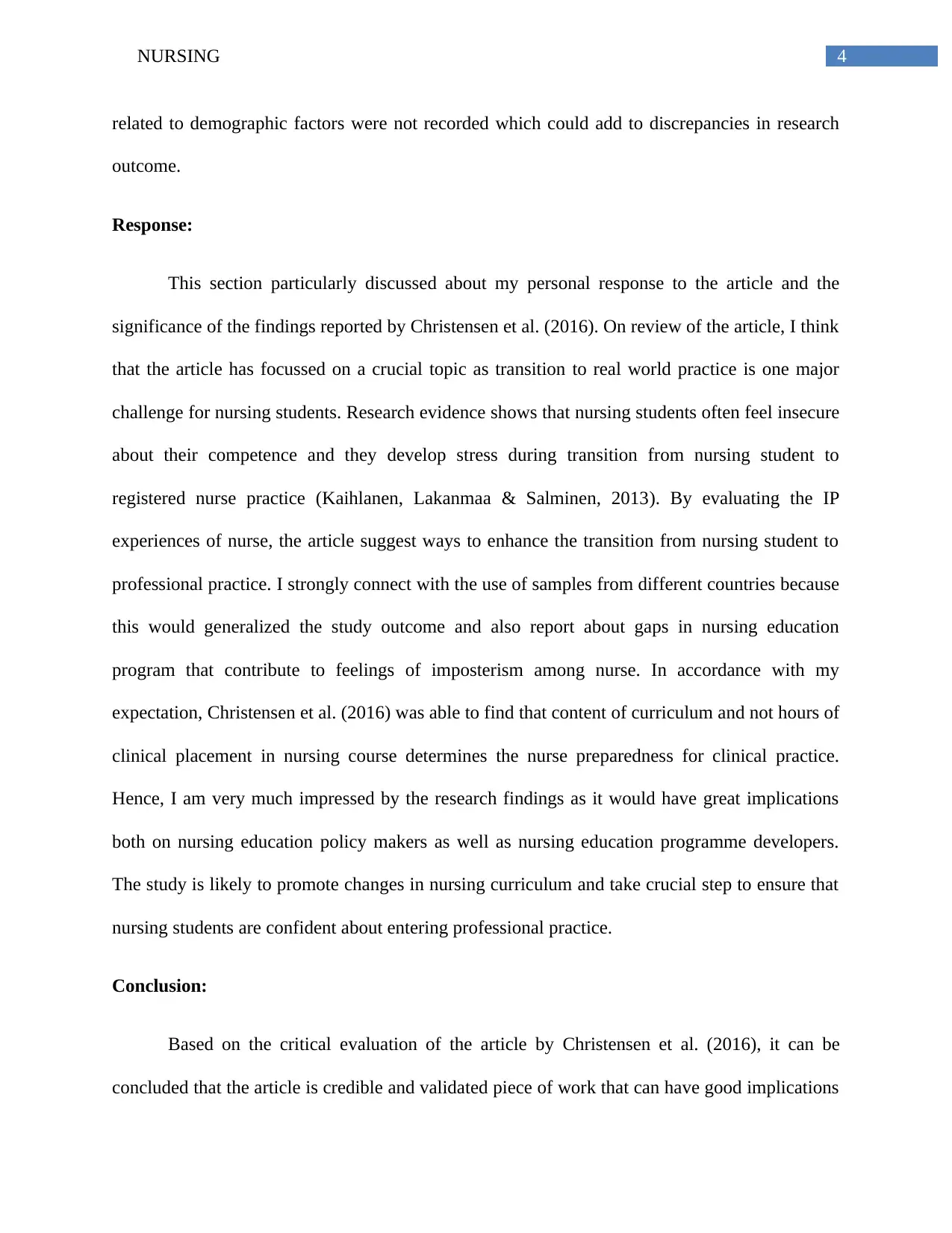
4NURSING
related to demographic factors were not recorded which could add to discrepancies in research
outcome.
Response:
This section particularly discussed about my personal response to the article and the
significance of the findings reported by Christensen et al. (2016). On review of the article, I think
that the article has focussed on a crucial topic as transition to real world practice is one major
challenge for nursing students. Research evidence shows that nursing students often feel insecure
about their competence and they develop stress during transition from nursing student to
registered nurse practice (Kaihlanen, Lakanmaa & Salminen, 2013). By evaluating the IP
experiences of nurse, the article suggest ways to enhance the transition from nursing student to
professional practice. I strongly connect with the use of samples from different countries because
this would generalized the study outcome and also report about gaps in nursing education
program that contribute to feelings of imposterism among nurse. In accordance with my
expectation, Christensen et al. (2016) was able to find that content of curriculum and not hours of
clinical placement in nursing course determines the nurse preparedness for clinical practice.
Hence, I am very much impressed by the research findings as it would have great implications
both on nursing education policy makers as well as nursing education programme developers.
The study is likely to promote changes in nursing curriculum and take crucial step to ensure that
nursing students are confident about entering professional practice.
Conclusion:
Based on the critical evaluation of the article by Christensen et al. (2016), it can be
concluded that the article is credible and validated piece of work that can have good implications
related to demographic factors were not recorded which could add to discrepancies in research
outcome.
Response:
This section particularly discussed about my personal response to the article and the
significance of the findings reported by Christensen et al. (2016). On review of the article, I think
that the article has focussed on a crucial topic as transition to real world practice is one major
challenge for nursing students. Research evidence shows that nursing students often feel insecure
about their competence and they develop stress during transition from nursing student to
registered nurse practice (Kaihlanen, Lakanmaa & Salminen, 2013). By evaluating the IP
experiences of nurse, the article suggest ways to enhance the transition from nursing student to
professional practice. I strongly connect with the use of samples from different countries because
this would generalized the study outcome and also report about gaps in nursing education
program that contribute to feelings of imposterism among nurse. In accordance with my
expectation, Christensen et al. (2016) was able to find that content of curriculum and not hours of
clinical placement in nursing course determines the nurse preparedness for clinical practice.
Hence, I am very much impressed by the research findings as it would have great implications
both on nursing education policy makers as well as nursing education programme developers.
The study is likely to promote changes in nursing curriculum and take crucial step to ensure that
nursing students are confident about entering professional practice.
Conclusion:
Based on the critical evaluation of the article by Christensen et al. (2016), it can be
concluded that the article is credible and validated piece of work that can have good implications
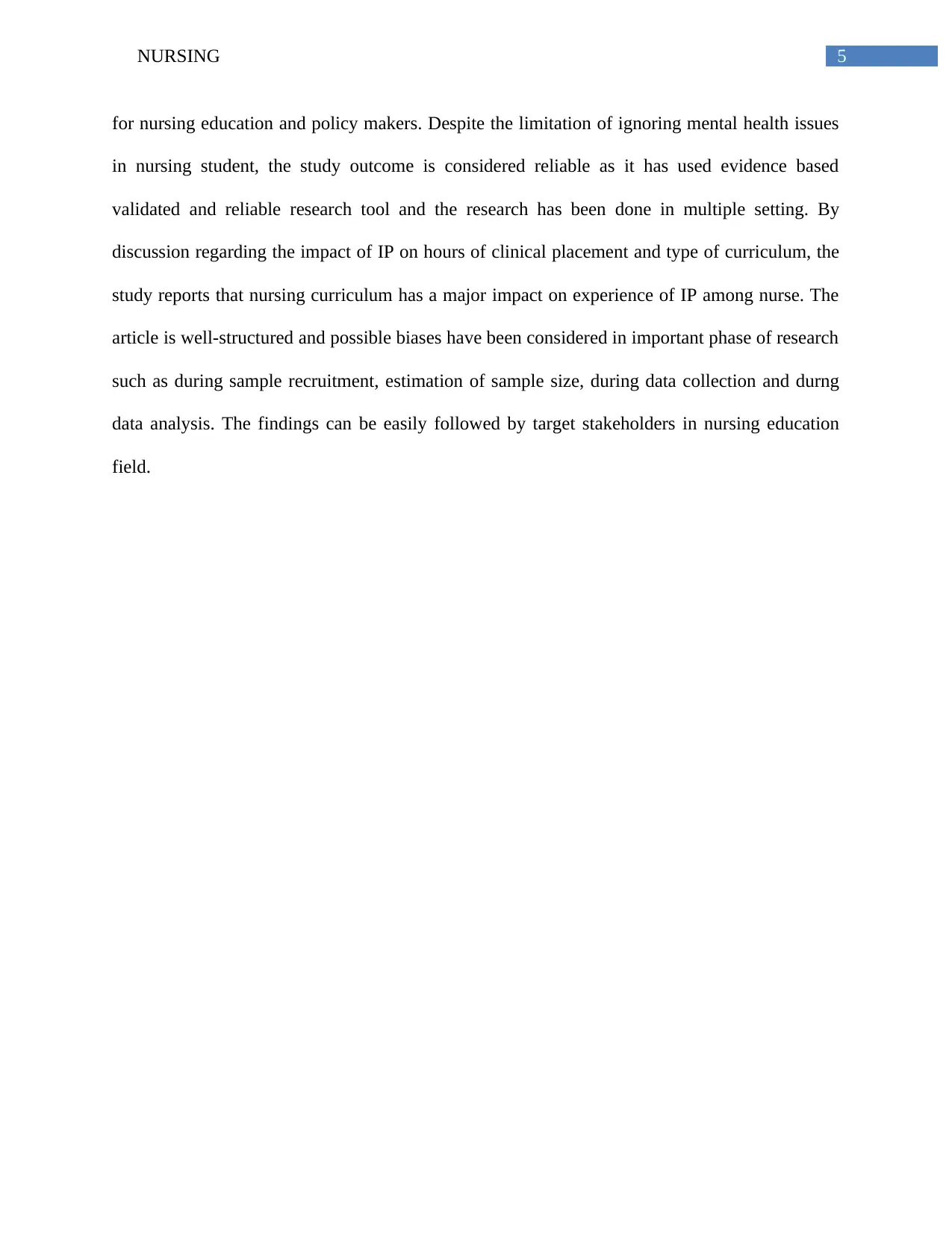
5NURSING
for nursing education and policy makers. Despite the limitation of ignoring mental health issues
in nursing student, the study outcome is considered reliable as it has used evidence based
validated and reliable research tool and the research has been done in multiple setting. By
discussion regarding the impact of IP on hours of clinical placement and type of curriculum, the
study reports that nursing curriculum has a major impact on experience of IP among nurse. The
article is well-structured and possible biases have been considered in important phase of research
such as during sample recruitment, estimation of sample size, during data collection and durng
data analysis. The findings can be easily followed by target stakeholders in nursing education
field.
for nursing education and policy makers. Despite the limitation of ignoring mental health issues
in nursing student, the study outcome is considered reliable as it has used evidence based
validated and reliable research tool and the research has been done in multiple setting. By
discussion regarding the impact of IP on hours of clinical placement and type of curriculum, the
study reports that nursing curriculum has a major impact on experience of IP among nurse. The
article is well-structured and possible biases have been considered in important phase of research
such as during sample recruitment, estimation of sample size, during data collection and durng
data analysis. The findings can be easily followed by target stakeholders in nursing education
field.
⊘ This is a preview!⊘
Do you want full access?
Subscribe today to unlock all pages.

Trusted by 1+ million students worldwide
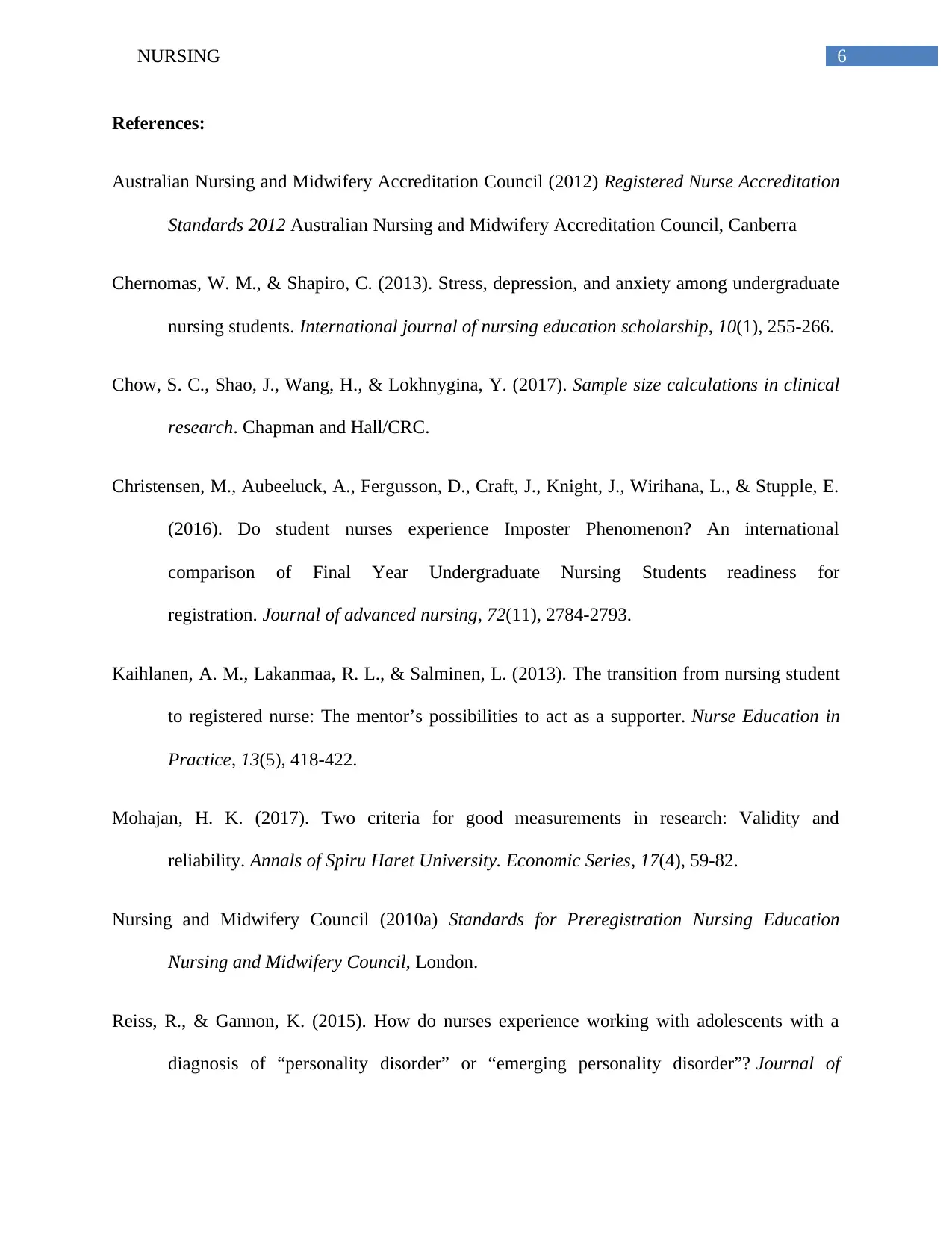
6NURSING
References:
Australian Nursing and Midwifery Accreditation Council (2012) Registered Nurse Accreditation
Standards 2012 Australian Nursing and Midwifery Accreditation Council, Canberra
Chernomas, W. M., & Shapiro, C. (2013). Stress, depression, and anxiety among undergraduate
nursing students. International journal of nursing education scholarship, 10(1), 255-266.
Chow, S. C., Shao, J., Wang, H., & Lokhnygina, Y. (2017). Sample size calculations in clinical
research. Chapman and Hall/CRC.
Christensen, M., Aubeeluck, A., Fergusson, D., Craft, J., Knight, J., Wirihana, L., & Stupple, E.
(2016). Do student nurses experience Imposter Phenomenon? An international
comparison of Final Year Undergraduate Nursing Students readiness for
registration. Journal of advanced nursing, 72(11), 2784-2793.
Kaihlanen, A. M., Lakanmaa, R. L., & Salminen, L. (2013). The transition from nursing student
to registered nurse: The mentor’s possibilities to act as a supporter. Nurse Education in
Practice, 13(5), 418-422.
Mohajan, H. K. (2017). Two criteria for good measurements in research: Validity and
reliability. Annals of Spiru Haret University. Economic Series, 17(4), 59-82.
Nursing and Midwifery Council (2010a) Standards for Preregistration Nursing Education
Nursing and Midwifery Council, London.
Reiss, R., & Gannon, K. (2015). How do nurses experience working with adolescents with a
diagnosis of “personality disorder” or “emerging personality disorder”? Journal of
References:
Australian Nursing and Midwifery Accreditation Council (2012) Registered Nurse Accreditation
Standards 2012 Australian Nursing and Midwifery Accreditation Council, Canberra
Chernomas, W. M., & Shapiro, C. (2013). Stress, depression, and anxiety among undergraduate
nursing students. International journal of nursing education scholarship, 10(1), 255-266.
Chow, S. C., Shao, J., Wang, H., & Lokhnygina, Y. (2017). Sample size calculations in clinical
research. Chapman and Hall/CRC.
Christensen, M., Aubeeluck, A., Fergusson, D., Craft, J., Knight, J., Wirihana, L., & Stupple, E.
(2016). Do student nurses experience Imposter Phenomenon? An international
comparison of Final Year Undergraduate Nursing Students readiness for
registration. Journal of advanced nursing, 72(11), 2784-2793.
Kaihlanen, A. M., Lakanmaa, R. L., & Salminen, L. (2013). The transition from nursing student
to registered nurse: The mentor’s possibilities to act as a supporter. Nurse Education in
Practice, 13(5), 418-422.
Mohajan, H. K. (2017). Two criteria for good measurements in research: Validity and
reliability. Annals of Spiru Haret University. Economic Series, 17(4), 59-82.
Nursing and Midwifery Council (2010a) Standards for Preregistration Nursing Education
Nursing and Midwifery Council, London.
Reiss, R., & Gannon, K. (2015). How do nurses experience working with adolescents with a
diagnosis of “personality disorder” or “emerging personality disorder”? Journal of
Paraphrase This Document
Need a fresh take? Get an instant paraphrase of this document with our AI Paraphraser

7NURSING
Psychiatric and Mental Health Nursing, 22(4), 244–250.
https://doi.org/10.1111/jpm.12213
Psychiatric and Mental Health Nursing, 22(4), 244–250.
https://doi.org/10.1111/jpm.12213
1 out of 8
Your All-in-One AI-Powered Toolkit for Academic Success.
+13062052269
info@desklib.com
Available 24*7 on WhatsApp / Email
![[object Object]](/_next/static/media/star-bottom.7253800d.svg)
Unlock your academic potential
Copyright © 2020–2025 A2Z Services. All Rights Reserved. Developed and managed by ZUCOL.


